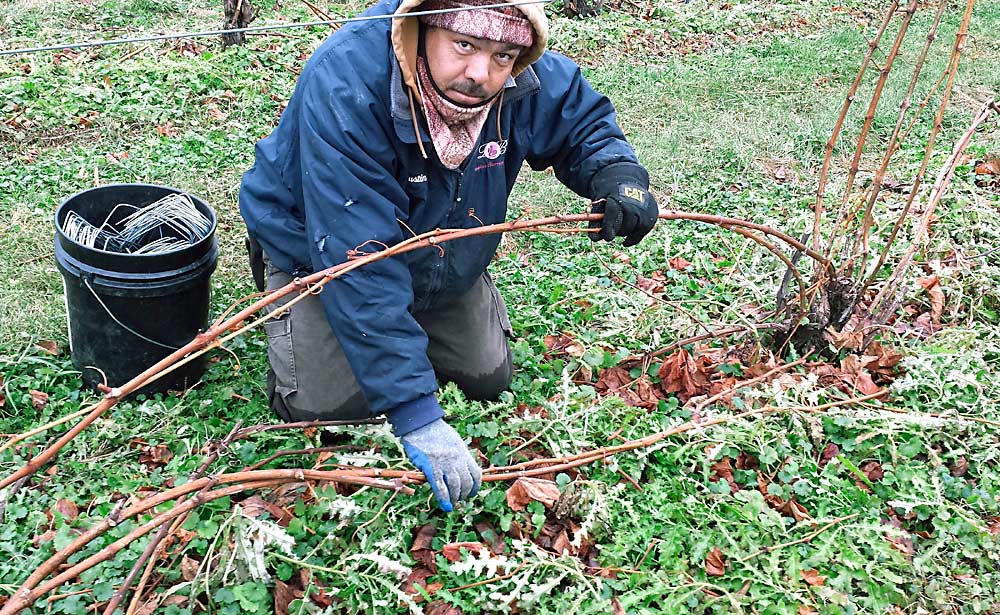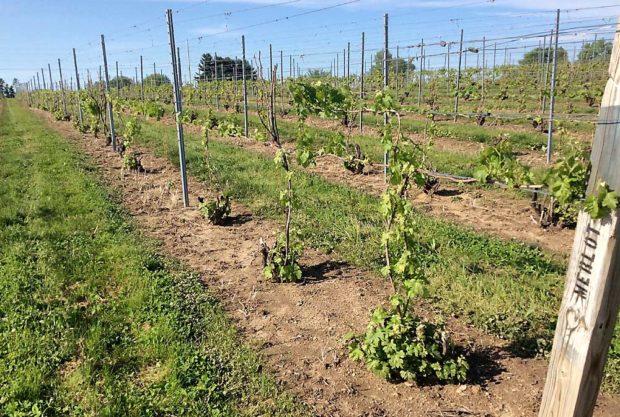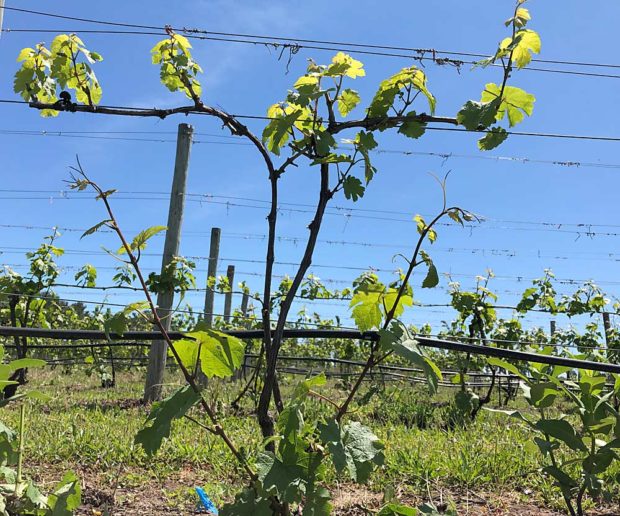
For grape growers in three Southwest Michigan counties, this past winter was brutal — again.
For the third year in the past six, the region experienced extreme “20-year” cold events that killed off vines and left growers wondering if this is the new normal and, if so, how they can continue to grow Vitis vinifera.
Another year, another die-off
“We hadn’t had a really cold event since January of 1994, when it got down to minus 27. So in 2014, when a polar vortex slid a slug of dangerously cold air off the North Pole and it sat on the Eastern United States, we figured, well, that’s not going to happen for another 20 years,” said Mark Longstroth, Michigan State University small fruit educator. “But then the same thing happened the next year in 2015 and again in 2019.”
Wind poses the big problem: Rather than coming from the west and getting the temperature-moderating effects of the comparatively warm water of Lake Michigan, the wind came from either the northeast or southwest, so the cold was unchecked.
This past winter was especially challenging because Southwest Michigan experienced two extreme-cold events in January. While most of Michigan’s fruit growing regions were unaffected, the damage to grapes in the bottom three counties in Southwest Michigan was massive.
“We’re looking at roughly 80 percent of vinifera in that region that was severely damaged to the point that a normal crop is impossible this year,” said Thomas Todaro, MSU viticulture educator. “This is going to be a year of retraining and recovering cold-tender varieties, which are also some of the most valuable varieties.”
Worrying trend
Grape growers in the three Southwest Michigan counties are “very concerned” about this spate of extreme cold events over the last six years, Longstroth said. Growers rebuilt the vines after the 2014 and 2015 events, and vineyard production was just getting back to normal last year.
“Then we had the 2019 winter, and I drove past all this acreage in early June where the only places I saw green shoots was in the high spots in the vineyards,” he said. That means it will be yet another three to four years to see full production again.
The repeated trauma can also make the vines more vulnerable to environmental stressors and pathogens, which can affect productivity and quality, Todaro said.
“This unpredictable and extreme weather has a lot of people just generally concerned about what they should expect, and whether their whole business plan is even viable,” he said. “In other words, they’re telling me they’re worried about whether this is the new normal and whether they can really do this if these are the types of winters that are ahead of them.”
That anxiety extends to other fruits in those three counties, too, Longstroth said. He estimated that fruit production in Concord grapes in those same three counties will be cut by half, and 15 to 25 percent of 3-year-old tart cherry trees will likely die this season, due to cold damage. In addition, most peach orchards experienced a complete crop loss due to bud kill.
“With these peach trees being frozen out again, growers are asking themselves if it’s ‘worth my time’ to grow peaches,” he said.
Beating the cold
Growers may not be able to control the weather, but they do have options to ride out these storms in better shape, Todaro said. One of the most effective preventative measures is cane burial.
“We had a few growers in Southwest Michigan who laid down canes of cold-tender varieties last fall and then buried them with the snow that came over the winter. That helped them protect their canes and, this year, they’ll be able to produce a near-normal crop,” he said, adding that some growers have found burying canes under soil or straw also works well.

One of the vineyards that practiced cane burial is the 40-acre vineyard of Domaine Berrien Cellars, which used the protective method on all of its cold-tender vinifera, said grower and winemaker Wally Maurer. He said he does it for the vines and for his own personal and professional satisfaction.
“I really look forward every year to painting a picture of what we did with the earth and the grapes and Mother Nature. It’s kind of that Old World style: I make wine because I love to make wine, and I don’t want to miss a season,” he said.
The process at Domaine Berrien involved laying down and covering canes that had been grown to between 68 and 72 inches over the season.
“It looks like we did a good job this year — a real good job — and I hope we’ll get a lot of fruit,” he said. “We grape growers are finding out that with three bad winters in six years, it’s becoming a new way of growing. If you can’t be without a crop for a given season, you’re going to have to practice some cane-laydown and burial system, whether it’s with straw, snow or dirt — whatever is economical for you — but we have to protect that vintage year and keep those vines healthy.”
Cane burial isn’t cheap. Todaro quoted a Cornell University study that placed the cost at about $400 to $500 per acre. Nonetheless, the cost seems to have been worth it this year.
“The proof is in the pudding,” he said. “We went out to Domaine Berrien at the end of May and their Cab Sauvs, Merlots and other cold-tender varieties all had leaves, while the vineyards next door didn’t. Cane burial made all the difference.”

Other options for growers include trying geotextiles to cover vines to protect them from winter cold; and adding drain tiling beneath newly planted vineyards, to control excess moisture and aid in cold acclimation, Todaro said.
For growers who experienced damage from the 2019 winter cold, he suggested they encourage the flush of shoot growth that will arise from the trunk base. “The important thing to do this season is to keep as many of those shoots as possible and grow them in a fan-shaped, two-dimensional plane orientation up into the trellis, because it will give them as much sun, airflow and spray penetration as possible,” he said.
This will also provide a greater selection of shoots for canes the following spring, so growers can pick the best ones for optimal fruiting.
“There’s no way to sidestep Mother Nature, but there are good ways to position yourself so that no matter what happens, you can still rebuild and can still produce fruit,” Todaro said. “And for any freeze-prone region — any region that has sustained significant vine dieback and severe winter temperatures — I think it’s something to consider very seriously.” •
—by Leslie Mertz
A double weather whammy

In Southwest Michigan, cold hit twice in 2019. Northeast winds ushered in the first event in mid-January. As the winds died, temperatures plummeted in the low and flat areas. “We had a really cold radiation freeze with snow on the ground and lows into the mid-minus-20s in the low areas, but above minus 10 in the good fruit sites where the peaches and wine grapes are,” said Mark Longstroth of Michigan State University.
In the second Arctic event, strong southwest winds dropped temperatures in the high sites to minus 17 and minus 18 for two nights in a row, “and the high barely got to zero in between,” he said, adding that this was a big problem for cold-tender vinifera such as Merlot and Cabernet Franc that cannot tolerate temperatures below minus 15, let alone two periods of minus 17 and lower.
—L. Mertz






Leave A Comment